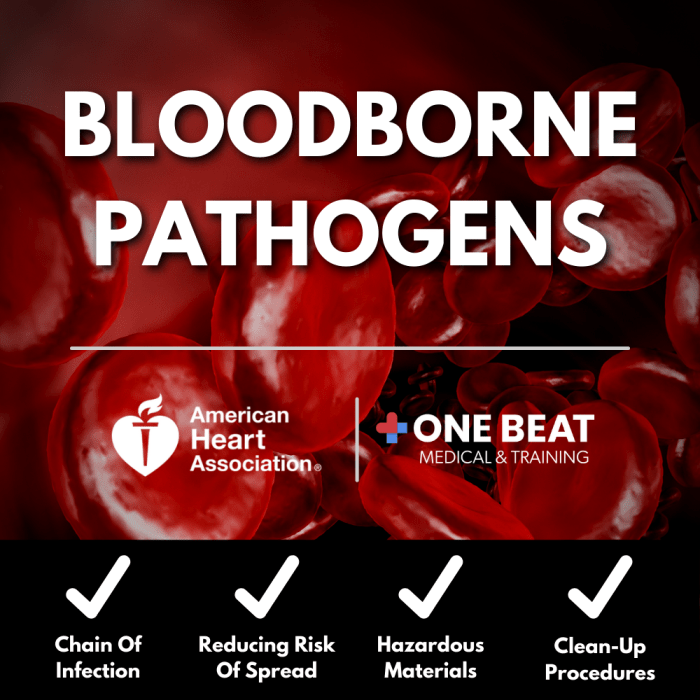Bloodborne pathogens training must be provided every 3 years – Bloodborne pathogens training must be provided every three years to ensure healthcare professionals are adequately prepared to handle blood and other potentially infectious materials. This training is crucial for preventing exposure and infection, and is mandated by regulatory bodies to safeguard both healthcare workers and patients.
This comprehensive training covers essential topics such as recognizing and avoiding bloodborne pathogens, proper handling and disposal of infectious materials, and post-exposure prophylaxis. Interactive training methods, such as simulations and case studies, effectively convey the material and enhance learning outcomes.
Bloodborne Pathogen Training Frequency and Regulatory Requirements

To minimize the risk of exposure to bloodborne pathogens and prevent occupational infections, healthcare workers must undergo regular training. The frequency of this training is mandated by regulatory bodies and is essential for maintaining compliance and protecting both employees and patients.
Regulatory Bodies and Training Frequency
- Occupational Safety and Health Administration (OSHA): Requires training within 10 days of initial assignment to a job with occupational exposure risk and annually thereafter.
- Centers for Disease Control and Prevention (CDC): Recommends training every 3 years or more frequently if there is a known or potential exposure risk.
Consequences of Non-Compliance
- Increased risk of occupational exposure and infection.
- Fines and penalties for non-compliance with regulatory requirements.
- Legal liability in the event of an employee infection or transmission.
Key Elements of Bloodborne Pathogen Training: Bloodborne Pathogens Training Must Be Provided Every 3 Years
Bloodborne pathogen training programs must cover specific topics to ensure that healthcare workers have the knowledge and skills necessary to prevent exposure and infection.
Essential Topics
- Definition and characteristics of bloodborne pathogens.
- Transmission modes and risk factors.
- Universal precautions and personal protective equipment (PPE).
- Exposure prevention and control measures.
- Post-exposure management and reporting.
Importance of Each Topic, Bloodborne pathogens training must be provided every 3 years
Each topic is crucial for preventing exposure and infection:
- Definition and characteristics:Understanding the nature of bloodborne pathogens is essential for recognizing potential hazards.
- Transmission modes and risk factors:Identifying how pathogens are transmitted helps healthcare workers avoid risky behaviors.
- Universal precautions and PPE:Universal precautions minimize the risk of exposure, while PPE provides additional protection.
- Exposure prevention and control measures:Proper handling of sharps, disinfection, and other practices prevent contamination.
- Post-exposure management and reporting:Prompt reporting and treatment of exposures can prevent infection and reduce its severity.
Target Audience and Training Delivery Methods

Bloodborne pathogen training is targeted at healthcare workers with potential exposure to blood or other potentially infectious materials.
Target Audience
- Nurses.
- Physicians.
- Technicians.
- Laboratory personnel.
- Housekeeping staff.
Training Delivery Methods
Training can be delivered through various methods:
In-Person Training
- Provides face-to-face interaction and hands-on practice.
- Facilitates group discussions and real-time feedback.
Online Training
- Convenient and accessible.
- Allows for self-paced learning and review.
Blended Learning
- Combines in-person and online elements.
- Provides flexibility and accommodates different learning styles.
Selecting the Most Appropriate Method
The choice of training method depends on factors such as:
- Target audience.
- Available resources.
- Learning preferences.
Evaluating Training Effectiveness
Evaluating the effectiveness of bloodborne pathogen training is crucial for ensuring that healthcare workers have acquired the necessary knowledge and skills.
Evaluation Methods
- Pre- and post-training assessments:Measure knowledge gain and identify areas for improvement.
- Skills demonstrations:Observe and evaluate practical skills, such as proper PPE use.
- Participant feedback:Collect feedback on training content, delivery, and effectiveness.
Importance of Tracking and Documentation
Tracking training records and maintaining documentation is essential for:
- Compliance:Demonstrating compliance with regulatory requirements.
- Quality improvement:Identifying areas for improvement in training programs.
- Employee protection:Verifying that employees have received adequate training to protect themselves from exposure.
Improving Training Programs
Evaluation results can be used to improve training programs by:
- Updating content:Incorporating new information and addressing identified knowledge gaps.
- Revising delivery methods:Adapting training to meet the needs of the target audience.
- Providing additional support:Offering refresher training or resources for ongoing education.
Best Practices for Bloodborne Pathogen Training

To design and implement effective bloodborne pathogen training programs, it is important to adhere to best practices.
Best Practices
- Engage learners:Use interactive methods and real-world examples to make training engaging and memorable.
- Tailor to audience:Customize training content and delivery to meet the specific needs of the target audience.
- Provide hands-on practice:Allow participants to practice skills, such as PPE donning and doffing, to reinforce learning.
- Emphasize prevention:Focus on practical measures to prevent exposure and infection, rather than solely on regulatory compliance.
- Promote ongoing education:Provide resources and encourage healthcare workers to engage in ongoing education and refresher training.
Examples of Successful Initiatives
Successful bloodborne pathogen training initiatives include:
- Hospital-based programs:Comprehensive programs that provide training to all healthcare workers with exposure risk.
- Online learning platforms:Interactive online courses that allow for self-paced learning and documentation.
- Community-based outreach:Programs that provide training to healthcare workers in underserved communities.
User Queries
Who is required to receive bloodborne pathogens training?
All healthcare workers who have potential exposure to blood or other potentially infectious materials.
What are the consequences of not receiving bloodborne pathogens training?
Healthcare workers who are not properly trained may be at risk of exposure and infection, and may face disciplinary action or legal liability.
How often should bloodborne pathogens training be provided?
Every three years, or more frequently if required by regulatory bodies or if there is a change in job responsibilities that increases the risk of exposure.